Taiwan Pineapple Varieties
The following is a translation, prepared by the Pineapple Blog, of a description of Taiwan's current commercial pineapple varieties. It -- together with the included photos -- is part of an on-line knowledge database maintained by the Taiwan Council of Agriculture (COA).
(Note: The term "tainung" means "Taiwan variety." The months specified after each entry appear to indicate the variety's seasonal availability.)
Pineapples
Taiwan produces many commercial varieties of pineapples. Current edible varieties include the Fu-Mu Cayenne and Tainung Nos. 4, 6, 11, 13, and 16-20.
I. Fu-Mu Cayenne 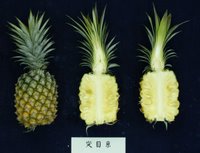
Commonly known as “No. 1” or “Fu-Mu” ("puffy eye"). It is a natural mutation of the Cayenne pineapple. The plant is smaller than the standard Cayenne; its leaves are narrow and spineless. The fruit is of short cylindrical shape, with slightly bulging fruitlets. It has a high percentage (~ more than 70%) of edible flesh. The flesh is translucent and golden. The average fruit weight is 1.3 kg, and is great for fresh eating. One drawback, however, is that the fruit tends to have multiple crowns (a cockscomb formation). May-June.
II. Tainung No. 4 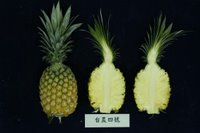
Commonly known as the “Cherimoya Pineapple.” It is also known as the “Easy Peeler” because it can be eaten by cutting the pineapple in half or into quarters, then pulling apart the fruitlets one by one, without having to peel. The plant is small and its leaves are spiny. The fruit is of cylindrical shape, except that fruits produced in early spring are usually pyramid- or cone-shaped. Tainung No. 4 has bulging fruitlets. The flesh is dense, with little fiber, and very fragrant. It is not very juicy. Sugar content is 19.5°Brix. Acidity is about 0.43%, and sugar-acid ratio is 45. The average fruit weight is 1.2 kg. Because it stores well and transports well, it used to be one of Taiwan’s main export fruits. March-May.
III. Tainung No. 6 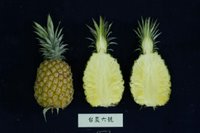
Because of its apple fragrance, Tainung No. 6 is commonly known as the “Apple Pineapple.” The leaves are green with a touch of red and are spiny. The fruit is cylindrical or ball shaped. Thin skinned. The flesh has a fine texture, delicate, crisp, and juicy. Sugar content is about 15.1°Brix. Acidity is about 0.34%, and sugar-acid ratio is 44. Excellent aroma. The average fruit weight is 1.3 kg. This is very popular in the fresh fruit market. April-May.
IV. Tainung No. 11 
Commonly known as the “Perfume Pineapple” because of its distinct fragrance. The plant is medium-sized. The leaves are erect and spineless. The fruit is cylindrical. The fruitlets are slightly bulging. The flesh has a fine texture and is juicy. Somewhat acidic. Sugar content is about 14.8°Brix. Acidity is about 0.57%. Sugar-acid ration is 26. The average fruit weight is 1.0 kg. The fruit stores well and transports well. It is very popular in the Japanese fresh fruit market. May-June.
V. Tainung No. 13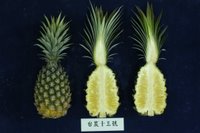
Commercially known as the “Winter Honey Pineapple.” The plant is tall. The leaves are long and erect, often with little spines near the tip and the base. The leaves are grass green, with a purple-red streak down the middle. The fruit is slightly cone shaped. The fruitlets are slightly bulging. The flesh is golden and somewhat fibrous (and thus the fruit is also known as the “Sugarcane Pineapple”). Sugar content is about 15.7°Brix. Acidity is about 0.27%. Sugar-acid ration is 58.1. Has a strong pineapple fragrance. The average fruit weight is 1.2 kg. Normal season is late June to mid July, but it can be induced to fruit any time of year. Therefore, among all the different varieties, Tainung No. 13 is especially suited for autumn/winter production. It can be induced to fruit between August and February when other varieties are not in season.
VI. Tainung No. 16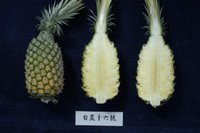
Commercially known as the “Sugar Honey Pineapple.” Other than at the tip, the leaves are spineless. The center of each leaf is light purple-red and ridged. The fruit is elongated cone or football shaped. The fruitlets are slightly bulging. The flesh is extremely delicate, with a fine texture. Sugar content is about 18°Brix. Acidity is about 0.47%. Sugar-acid ratio is 38.3. Excellent aroma. Average fruit weight is 1.3 kg. April-July.
VII. Tainung No. 17 
Commercially known as the “Golden Diamond.” The plant is medium sized. Other than the tip, the leaves are spineless. The leaves are slightly rust colored, green at the ends. The fruit is cylindrical, thin skinned, with shallow flower bracts. The flesh is deep yellow or golden and delicate. The core is relatively large, but tender and edible. Sugar content is about 14.1°Brix. Acidity is about 0.28%. Sugar-acid ratio is 50.4. Taste and aroma are both excellent. The average fruit weight is 1.4 kg. March-May.
VIII. Tainung No. 18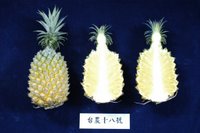
Commercially known as the “Golden Osmanthus.” The plant is small. Spineless. The leaves are green, but the center is slightly dark red. The fruit is cone shaped. The fruitlets are slightly bulging. Thin skinned, with shallow flower bracts. The flesh is yellow or golden, and in the mid-range of fibrousness. Sugar content is about 14.1°Brix. Acidity is about 0.39%. Sugar-acid ratio is 38.7. Has an osmanthus fragrance. The average fruit weight is 1.5 kg. April-July.
IX. Tainung No. 19 
Commercially known as the “Honey Treasure Pineapple.” Small plant. Other than the tip, the leaves are spineless. The leaves are deep green. The fruit is cylindrical, with many small fruitlets. Thin skinned, with shallow flower bracts. The flesh is golden, delicate, and with a fine texture. Sugar content is about 16.7°Brix. Acidity is about 0.46%. Sugar-acid ratio is 37.8. The average fruit weight is 1.6 kg. April-July and Oct.-Nov.
X. Tainung No. 20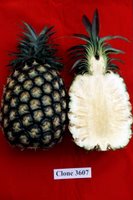
Commercially known as the “Milk” pineapple. Tall, large plant. Spineless. The leaves are deep green. The fruit is cylindrical, with many small fruitlets. Thin skinned, with shallow flower bracts. The flesh is milky white, delicate, and with a fine texture. Very fragrant. The average fruit weight is 1.3 kg. May-Oct.

<< Home